An Improved CH4 Profile Retrieving Method for Ground-Based Differential Absorption Lidar
Abstract
1. Introduction
2. Data and Study Area
2.1. Study Area
2.2. CH4-DIAL
2.3. Auxiliary Data
3. Methods
3.1. DIAL Principle
3.2. Cubic Smoothing Spline Fitting
- The left endpoint function value of each interpolation function is equal to its left endpoint sample value.
- Except for the first and last endpoints, the left and right first derivatives of the middle endpoints are equal.
- Except for the first and last endpoints, the left and right second derivatives of the middle endpoints are equal.
3.3. Statistical Method
4. Results and Discussion
4.1. Simulations
4.2. Case Verification
4.3. Diurnal Variation
4.4. Monthly and Seasonal Variation
5. Conclusions
Author Contributions
Funding
Institutional Review Board Statement
Informed Consent Statement
Data Availability Statement
Conflicts of Interest
References
- Rogelj, J.; den Elzen, M.; Höhne, N.; Fransen, T.; Fekete, H.; Winkler, H.; Schaeffer, R.; Sha, F.; Riahi, K.; Meinshausen, M. Paris Agreement Climate Proposals Need a Boost to Keep Warming Well below 2 °C. Nature 2016, 534, 631–639. [Google Scholar] [CrossRef] [PubMed]
- Tian, H.; Lu, C.; Ciais, P.; Michalak, A.M.; Canadell, J.G.; Saikawa, E.; Huntzinger, D.N.; Gurney, K.R.; Sitch, S.; Zhang, B.; et al. The Terrestrial Biosphere as a Net Source of Greenhouse Gases to the Atmosphere. Nature 2016, 531, 225–228. [Google Scholar] [CrossRef] [PubMed]
- Dean, J.F.; Middelburg, J.J.; Röckmann, T.; Aerts, R.; Blauw, L.G.; Egger, M.; Jetten, M.S.M.; de Jong, A.E.E.; Meisel, O.H.; Rasigraf, O.; et al. Methane Feedbacks to the Global Climate System in a Warmer World. Rev. Geophys. 2018, 56, 207–250. [Google Scholar] [CrossRef]
- Hasegawa, T.; Sakurai, G.; Fujimori, S.; Takahashi, K.; Hijioka, Y.; Masui, T. Extreme Climate Events Increase Risk of Global Food Insecurity and Adaptation Needs. Nat. Food 2021, 2, 587–595. [Google Scholar] [CrossRef] [PubMed]
- Zittis, G.; Almazroui, M.; Alpert, P.; Ciais, P.; Cramer, W.; Dahdal, Y.; Fnais, M.; Francis, D.; Hadjinicolaou, P.; Howari, F.; et al. Climate Change and Weather Extremes in the Eastern Mediterranean and Middle East. Rev. Geophys. 2022, 60, e2021RG000762. [Google Scholar] [CrossRef]
- Cai, W.; Wang, G.; Dewitte, B.; Wu, L.; Santoso, A.; Takahashi, K.; Yang, Y.; Carreric, A.; McPhaden, M.J. Increased Variability of Eastern Pacific El Nino under Greenhouse Warming. Nature 2018, 564, 201–206. [Google Scholar] [CrossRef] [PubMed]
- Jones, M.W.; Peters, G.P.; Gasser, T.; Andrew, R.M.; Schwingshackl, C.; Guetschow, J.; Houghton, R.A.; Friedlingstein, P.; Pongratz, J.; Le Quere, C. National Contributions to Climate Change Due to Historical Emissions of Carbon Dioxide, Methane, and Nitrous Oxide since 1850. Sci. Data 2023, 10, 155. [Google Scholar] [CrossRef] [PubMed]
- Arndt, C.; Hristov, A.N.; Price, W.J.; McClelland, S.C.; Pelaez, A.M.; Cueva, S.F.; Oh, J.; Dijkstra, J.; Bannink, A.; Bayat, A.R.; et al. Full Adoption of the Most Effective Strategies to Mitigate Methane Emissions by Ruminants Can Help Meet the 1.5 °C Target by 2030 but Not 2050. Proc. Natl. Acad. Sci. USA 2022, 119, e2111294119. [Google Scholar] [CrossRef] [PubMed]
- Intergovernmental Panel on Climate Change (IPCC) (Ed.) Anthropogenic and Natural Radiative Forcing. In Climate Change 2013—The Physical Science Basis: Working Group I Contribution to the Fifth Assessment Report of the Intergovernmental Panel on Climate Change; Cambridge University Press: Cambridge, UK, 2014; pp. 659–740. ISBN 978-1-107-05799-9. [Google Scholar]
- World Meteorological Organization. WMO Greenhouse Gas Bulletin No. 19; The state of greenhouse gases in the atmosphere based on global observations through 2022; World Meteorological Organization: Geneva, Switzerland, 2023. [Google Scholar]
- Ehhalt, D.H.; Schmidt, U. Sources and Sinks of Atmospheric Methane. PAGEOPH 1978, 116, 452–464. [Google Scholar] [CrossRef]
- Turner, A.J.; Frankenberg, C.; Kort, E.A. Interpreting Contemporary Trends in Atmospheric Methane. Proc. Natl. Acad. Sci. USA 2019, 116, 2805–2813. [Google Scholar] [CrossRef]
- Prather, M.J.; Holmes, C.D.; Hsu, J. Reactive Greenhouse Gas Scenarios: Systematic Exploration of Uncertainties and the Role of Atmospheric Chemistry. Geophys. Res. Lett. 2012, 39. [Google Scholar] [CrossRef]
- Jacob, D.J.; Turner, A.J.; Maasakkers, J.D.; Sheng, J.; Sun, K.; Liu, X.; Chance, K.; Aben, I.; McKeever, J.; Frankenberg, C. Satellite Observations of Atmospheric Methane and Their Value for Quantifying Methane Emissions. Atmos. Chem. Phys. 2016, 16, 14371–14396. [Google Scholar] [CrossRef]
- Messerschmidt, J.; Geibel, M.C.; Blumenstock, T.; Chen, H.; Deutscher, N.M.; Engel, A.; Feist, D.G.; Gerbig, C.; Gisi, M.; Hase, F.; et al. Calibration of TCCON Column-Averaged CO2: The First Aircraft Campaign over European TCCON Sites. Atmos. Chem. Phys. 2011, 11, 10765–10777. [Google Scholar] [CrossRef]
- Laughner, J.L.; Toon, G.C.; Mendonca, J.; Petri, C.; Roche, S.; Wunch, D.; Blavier, J.-F.; Griffith, D.W.T.; Heikkinen, P.; Keeling, R.F.; et al. The Total Carbon Column Observing Network’s GGG2020 Data Version. Earth Syst. Sci. Data 2024, 16, 2197–2260. [Google Scholar] [CrossRef]
- Jacob, D.J.; Varon, D.J.; Cusworth, D.H.; Dennison, P.E.; Frankenberg, C.; Gautam, R.; Guanter, L.; Kelley, J.; McKeever, J.; Ott, L.E.; et al. Quantifying Methane Emissions from the Global Scale down to Point Sources Using Satellite Observations of Atmospheric Methane. Atmos. Chem. Phys. 2022, 22, 9617–9646. [Google Scholar] [CrossRef]
- Kiemle, C.; Ehret, G.; Amediek, A.; Fix, A.; Quatrevalet, M.; Wirth, M. Potential of Spaceborne Lidar Measurements of Carbon Dioxide and Methane Emissions from Strong Point Sources. Remote Sens. 2017, 9, 1137. [Google Scholar] [CrossRef]
- Liang, A.; Gong, W.; Han, G.; Xiang, C. Comparison of Satellite-Observed XCO2 from GOSAT, OCO-2, and Ground-Based TCCON. Remote Sens. 2017, 9, 1033. [Google Scholar] [CrossRef]
- Riris, H.; Numata, K.; Wu, S.; Gonzalez, B.; Rodriguez, M.; Kawa, S.; Mao, J. Methane Measurements from Space: Technical Challenges and Solutions. In Laser Radar Technology and Applications XXII, 5 May 2017; SPIE: Bellingham, WT, USA, 2017; Volume 10191, pp. 17–26. [Google Scholar]
- Kiemle, C.; Kawa, S.R.; Quatrevalet, M.; Browell, E.V. Performance Simulations for a Spaceborne Methane Lidar Mission. J. Geophys. Res. Atmos. 2014, 119, 4365–4379. [Google Scholar] [CrossRef]
- Weaver, C.; Kiemle, C.; Kawa, S.R.; Aalto, T.; Necki, J.; Steinbacher, M.; Arduini, J.; Apadula, F.; Berkhout, H.; Hatakka, J. Retrieval of Methane Source Strengths in Europe Using a Simple Modeling Approach to Assess the Potential of Spaceborne Lidar Observations. Atmos. Chem. Phys. 2014, 14, 2625–2637. [Google Scholar] [CrossRef]
- Zhang, X.; Zhang, M.; Bu, L.; Fan, Z.; Mubarak, A. Simulation and Error Analysis of Methane Detection Globally Using Spaceborne IPDA Lidar. Remote Sens. 2023, 15, 3239. [Google Scholar] [CrossRef]
- Tellier, Y.; Pierangelo, C.; Wirth, M.; Gibert, F.; Marnas, F. Averaging Bias Correction for the Future Space-Borne Methane IPDA Lidar Mission MERLIN. Atmos. Meas. Tech. 2018, 11, 5865–5884. [Google Scholar] [CrossRef]
- Han, G.; Xu, H.; Gong, W.; Liu, J.; Du, J.; Ma, X.; Liang, A. Feasibility Study on Measuring Atmospheric CO2 in Urban Areas Using Spaceborne CO2-IPDA LIDAR. Remote Sens. 2018, 10, 985. [Google Scholar] [CrossRef]
- Refaat, T.F.; Ismail, S.; Nehrir, A.R.; Hair, J.W.; Crawford, J.H.; Leifer, I.; Shuman, T. Performance Evaluation of a 1.6-Μm Methane DIAL System from Ground, Aircraft and UAV Platforms. Opt. Express 2013, 21, 30415–30432. [Google Scholar] [CrossRef] [PubMed]
- Hrad, M.; Huber-Humer, M.; Reinelt, T.; Spangl, B.; Flandorfer, C.; Innocenti, F.; Yngvesson, J.; Fredenslund, A.; Scheutz, C. Determination of Methane Emissions from Biogas Plants, Using Different Quantification Methods. Agric. For. Meteorol. 2022, 326, 109179. [Google Scholar] [CrossRef]
- Ma, X.; Shi, T.; Xu, H.; He, B.; Qiu, R.; Han, G.; Gong, W. On-Line Wavenumber Optimization for a Ground-Based CH4-DIAL. J. Quant. Spectrosc. Radiat. Transf. 2019, 229, 106–119. [Google Scholar] [CrossRef]
- Philip, S.; Johnson, M.S.; Potter, C.; Genovesse, V.; Baker, D.F.; Haynes, K.D.; Henze, D.K.; Liu, J.; Poulter, B. Prior Biosphere Model Impact on Global Terrestrial CO2 Fluxes Estimated from OCO-2 Retrievals. Atmos. Chem. Phys. 2019, 19, 13267–13287. [Google Scholar] [CrossRef]
- Agusti-Panareda, A.; Massart, S.; Chevallier, F.; Boussetta, S.; Balsamo, G.; Beljaars, A.; Ciais, P.; Deutscher, N.M.; Engelen, R.; Jones, L.; et al. Forecasting Global Atmospheric CO2. Atmos. Chem. Phys. 2014, 14, 11959–11983. [Google Scholar] [CrossRef]
- Han, G.; Gong, W.; Lin, H.; Ma, X.; Xiang, Z. Study on Influences of Atmospheric Factors on Vertical CO2 Profile Retrieving From Ground-Based DIAL at 1.6 Μm. IEEE Trans. Geosci. Remote Sens. 2015, 53, 3221–3234. [Google Scholar] [CrossRef]
- Han, G.; Cui, X.; Liang, A.; Ma, X.; Zhang, T.; Gong, W. A CO2 Profile Retrieving Method Based on Chebyshev Fitting for Ground-Based DIAL. IEEE Trans. Geosci. Remote Sens. 2017, 55, 6099–6110. [Google Scholar] [CrossRef]
- NOAA U.S. Standard Atmosphere 1976. Available online: https://www.ngdc.noaa.gov/stp/space-weather/online-publications/miscellaneous/us-standard-atmosphere-1976/us-standard-atmosphere_st76-1562_noaa.pdf (accessed on 5 July 2024).
- Satar, E.; Berhanu, T.A.; Brunner, D.; Henne, S.; Leuenberger, M. Continuous CO2/CH4/CO Measurements (2012–2014) at Beromünster Tall Tower Station in Switzerland. Biogeosciences 2016, 13, 2623–2635. [Google Scholar] [CrossRef]
- Tong, X.; Scheeren, B.; Bosveld, F.; Hensen, A.; Frumau, A.; Meijer, H.A.J.; Chen, H. Magnitude and Seasonal Variation of N2O and CH4 Emissions over a Mixed Agriculture-Urban Region. Agric. For. Meteorol. 2023, 334, 109433. [Google Scholar] [CrossRef]
- Anderson, D.C.; Duncan, B.N.; Fiore, A.M.; Baublitz, C.B.; Follette-Cook, M.B.; Nicely, J.M.; Wolfe, G.M. Spatial and Temporal Variability in the Hydroxyl (OH) Radical: Understanding the Role of Large-Scale Climate Features and Their Influence on OH through Its Dynamical and Photochemical Drivers. Atmos. Chem. Phys. 2021, 21, 6481–6508. [Google Scholar] [CrossRef]
- Montzka, S.A.; Dlugokencky, E.J.; Butler, J.H. Non-CO2 Greenhouse Gases and Climate Change. Nature 2011, 476, 43–50. [Google Scholar] [CrossRef] [PubMed]
- Kavitha, M.; Nair, P.R.; Girach, I.A.; Aneesh, S.; Sijikumar, S.; Renju, R. Diurnal and Seasonal Variations in Surface Methane at a Tropical Coastal Station: Role of Mesoscale Meteorology. Sci. Total Environ. 2018, 631–632, 1472–1485. [Google Scholar] [CrossRef] [PubMed]
- Shan, M.; Xu, H.; Han, L.; Pang, Y.; Ma, J.; Zhang, C. Temporal Variation and Source Analysis of Atmospheric CH4 at Different Altitudes in the Background Area of Yangtze River Delta. Atmosphere 2022, 13, 1206. [Google Scholar] [CrossRef]
- Xia, L.; Zhang, G.; Zhan, M.; Li, B.; Kong, P. Seasonal Variations of Atmospheric CH4 at Jingdezhen Station in Central China: Understanding the Regional Transport and Its Correlation with CO2 and CO. Atmos. Res. 2020, 241, 104982. [Google Scholar] [CrossRef]
- Dimitriou, K.; Bougiatioti, A.; Ramonet, M.; Pierros, F.; Michalopoulos, P.; Liakakou, E.; Solomos, S.; Quehe, P.-Y.; Delmotte, M.; Gerasopoulos, E.; et al. Greenhouse Gases (CO2 and CH4) at an Urban Background Site in Athens, Greece: Levels, Sources and Impact of Atmospheric Circulation. Atmos. Environ. 2021, 253, 118372. [Google Scholar] [CrossRef]
- Wu, X.; Zhang, X.; Chuai, X.; Huang, X.; Wang, Z. Long-Term Trends of Atmospheric CH4 Concentration across China from 2002 to 2016. Remote Sens. 2019, 11, 538. [Google Scholar] [CrossRef]
- Qing, X.; Qi, B.; Lin, Y.; Chen, Y.; Zang, K.; Liu, S.; Ma, Q.; Qiu, S.; Jiang, K.; Xiong, H.; et al. Characteristics of the Methane (CH4) Mole Fraction in a Typical City and Suburban Site in the Yangtze River Delta, China. Atmos. Pollut. Res. 2022, 13, 101498. [Google Scholar] [CrossRef]
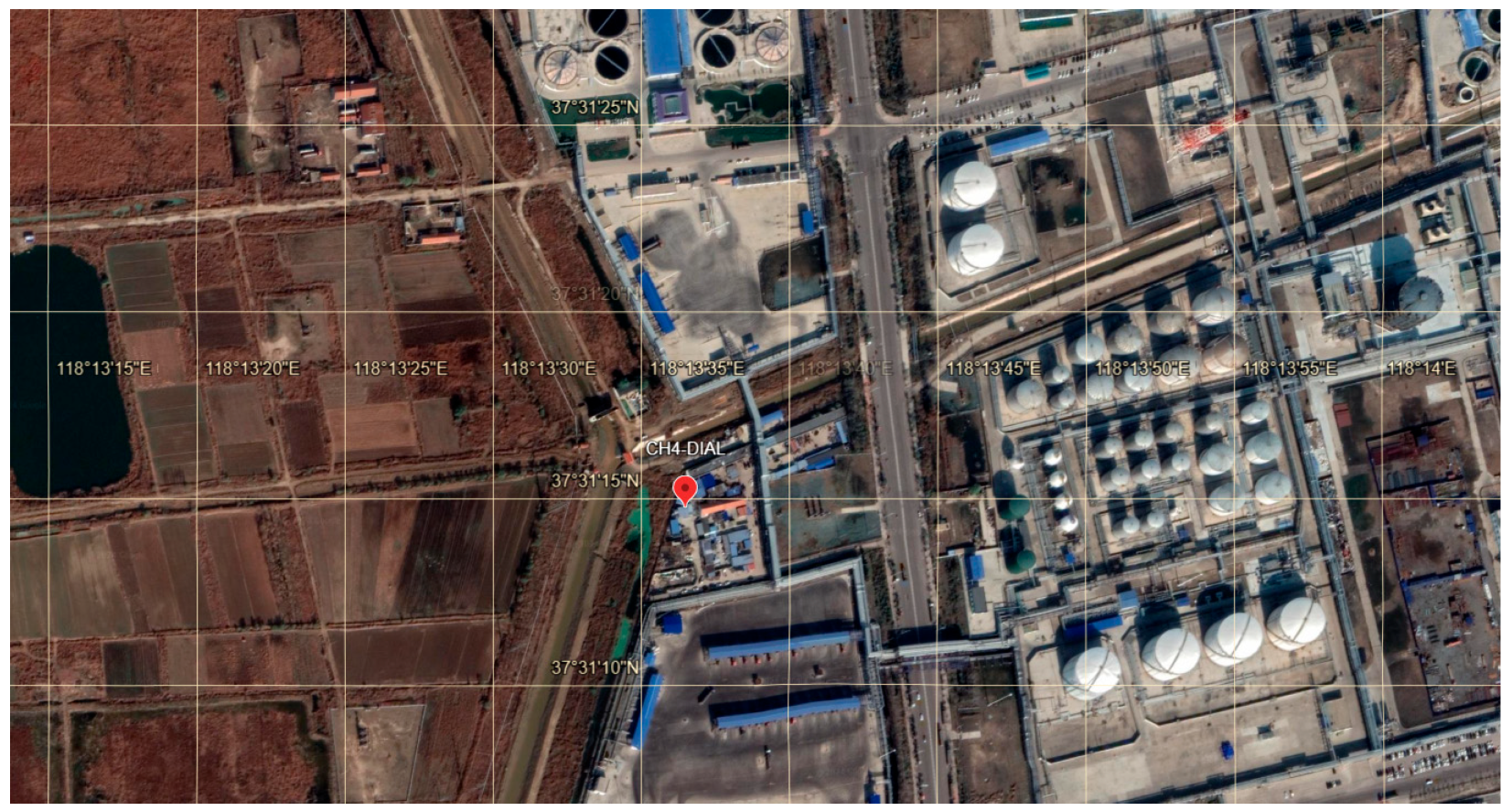
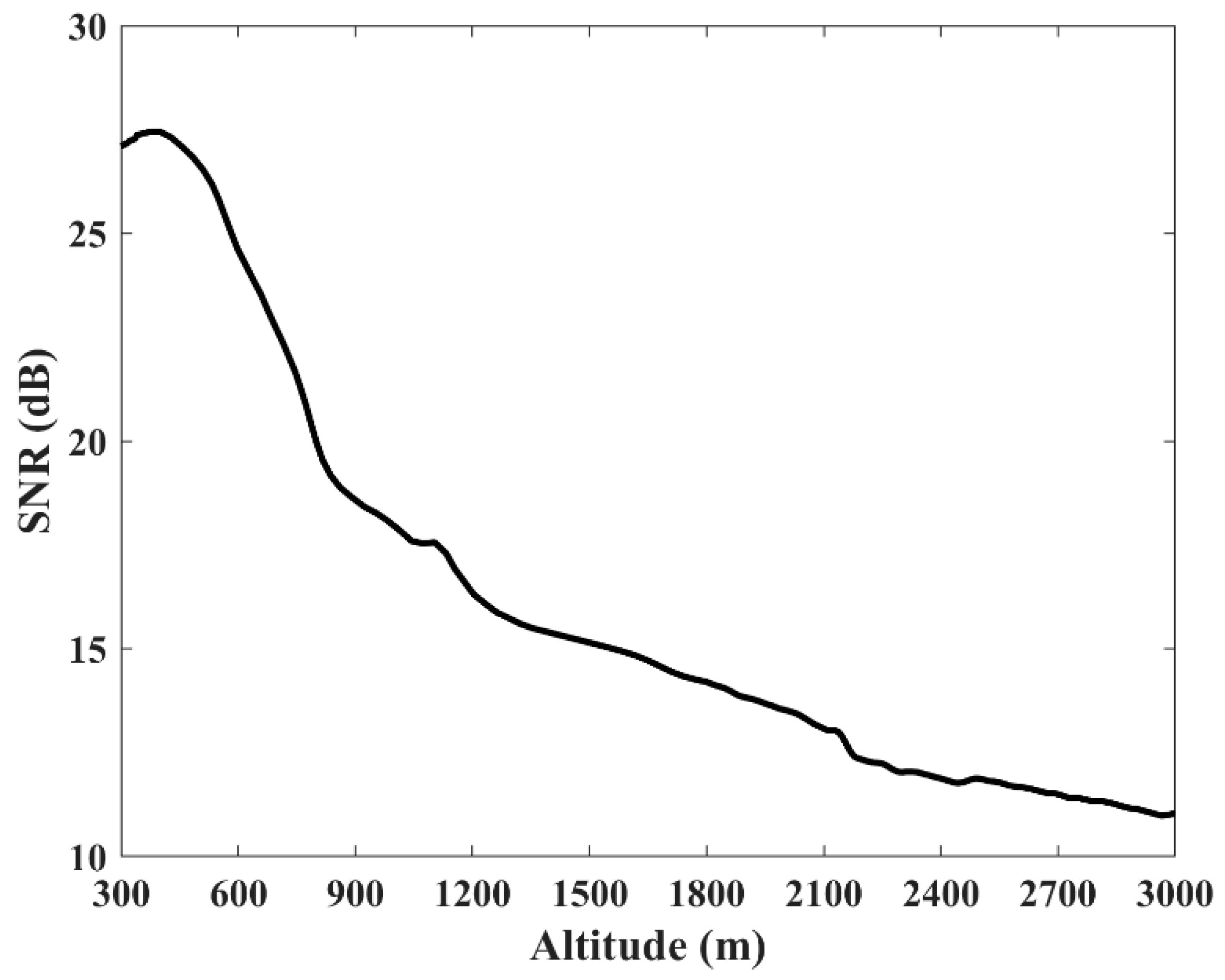

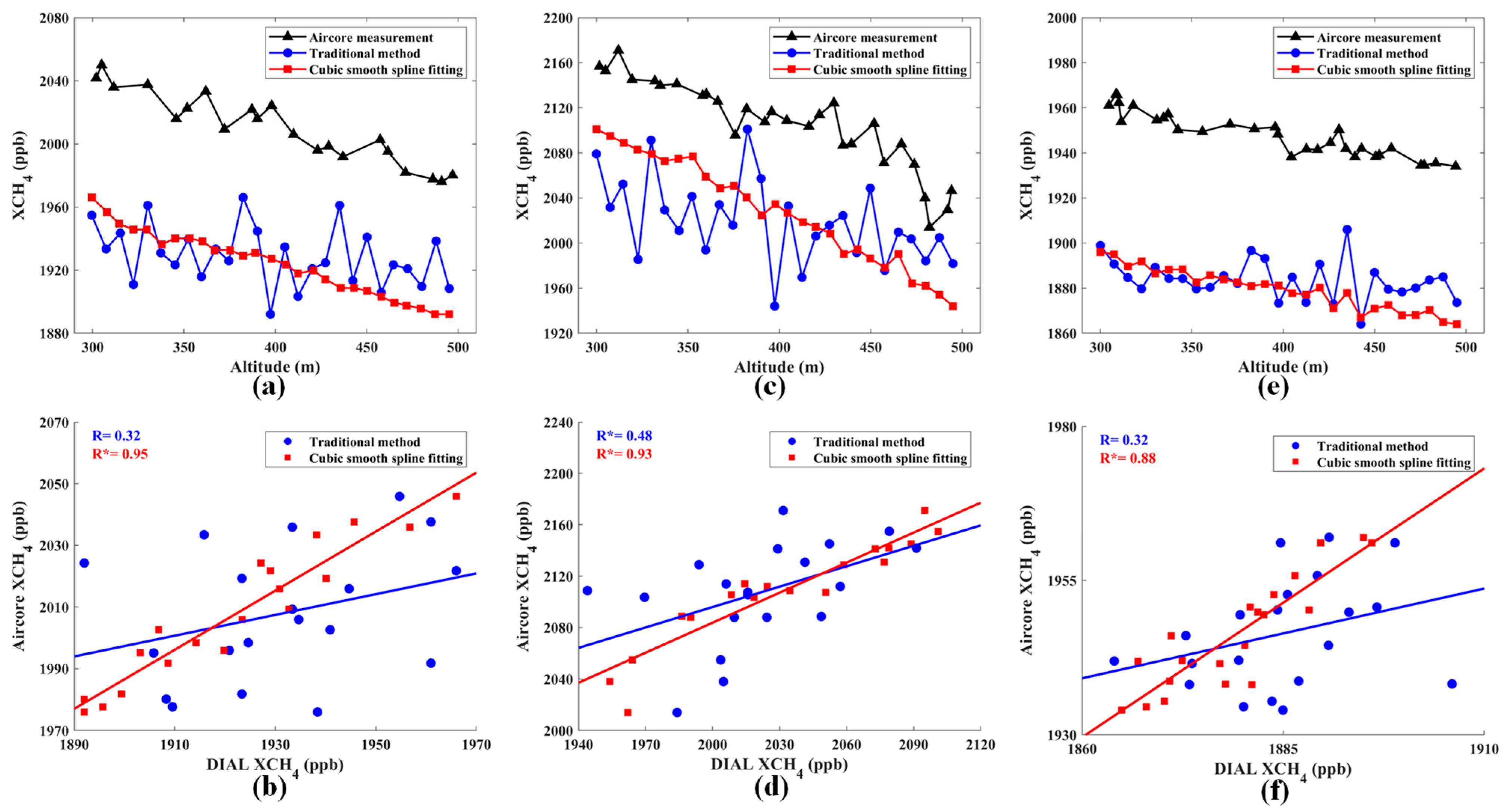
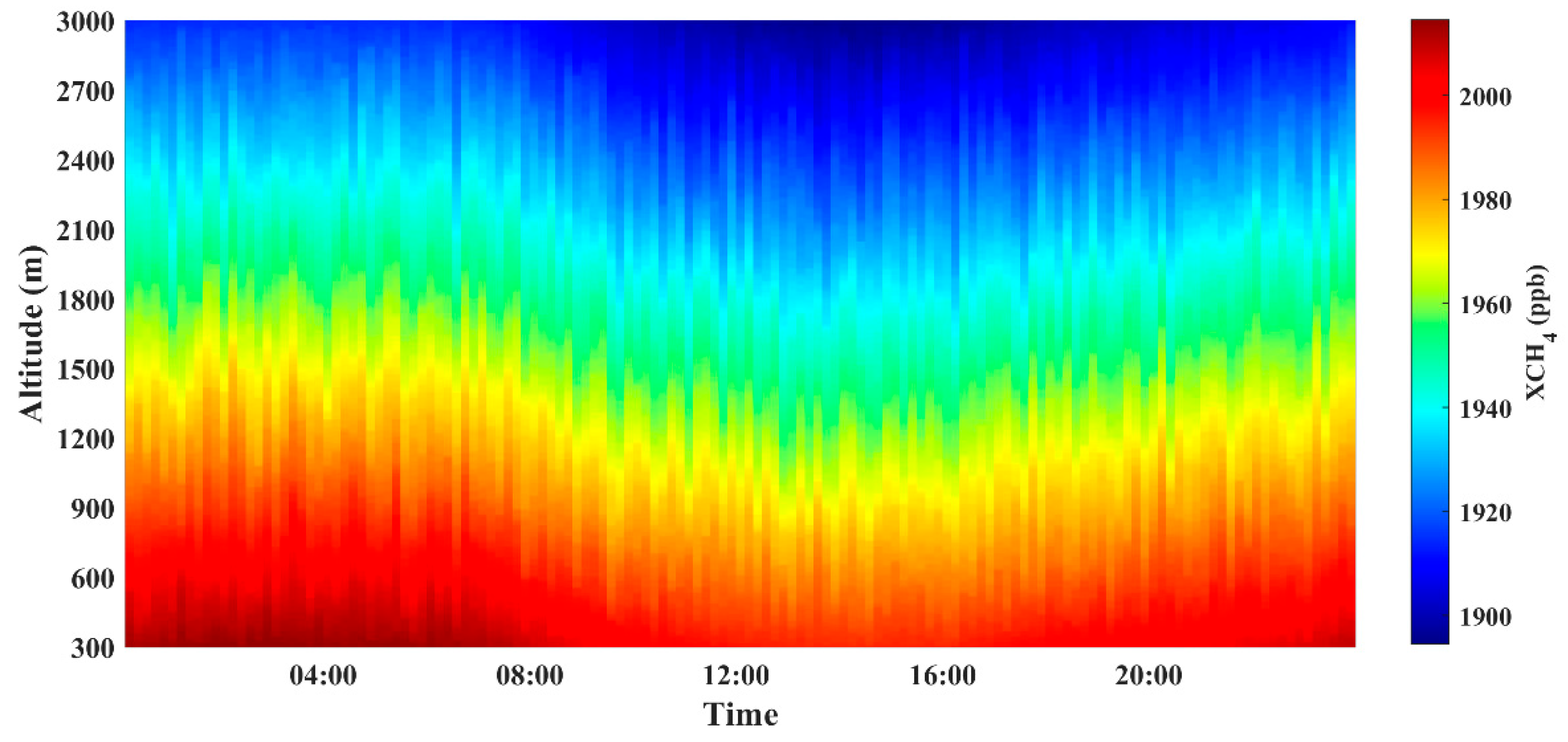
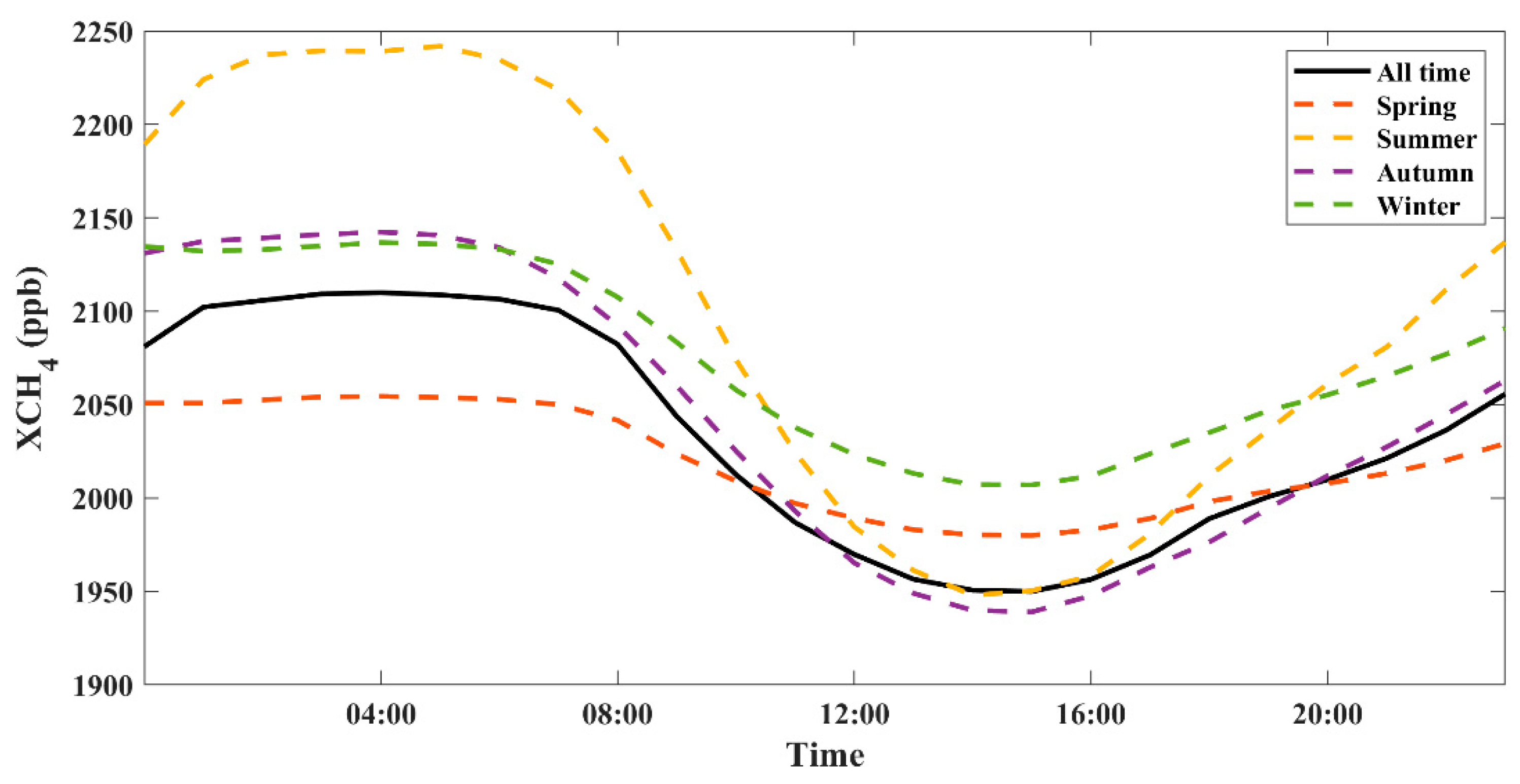
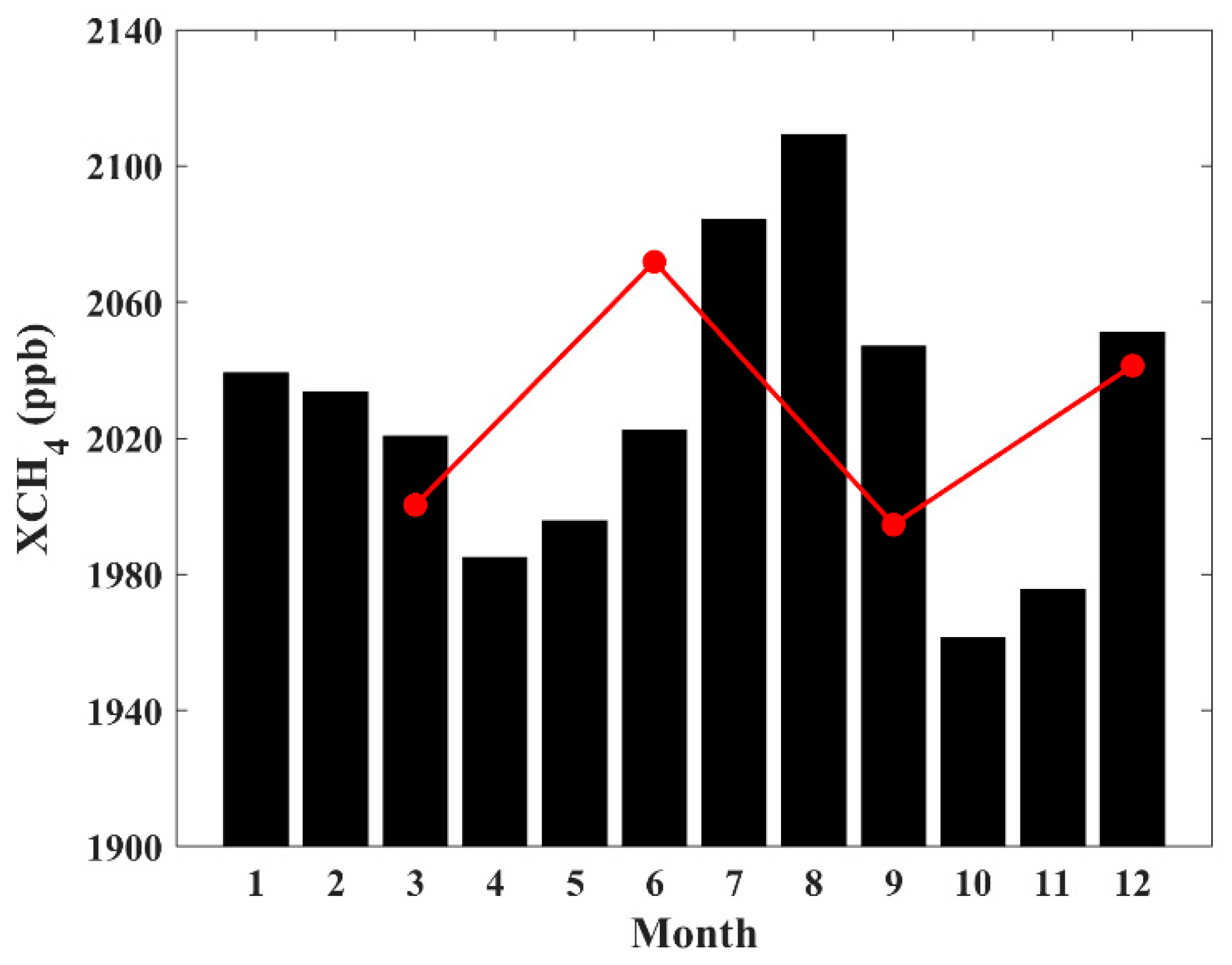
| Paramter | Value |
|---|---|
| On-line (cm−1) | 6076.984 |
| Off-line (cm−1) | 6077.653 |
| Pulse energy (mJ) | 21 |
| Repetition rate (Hz) | 20 |
| Pulse length (ns) | 10 |
| Linewidth (MHz) | 200 |
| Telescope Diameter (mm) | 400 |
| Beam divergence (mrad) | 0.1 |
| Overall optical efficient | 52.6 |
| Quantum efficiency (%) | 85 |
Disclaimer/Publisher’s Note: The statements, opinions and data contained in all publications are solely those of the individual author(s) and contributor(s) and not of MDPI and/or the editor(s). MDPI and/or the editor(s) disclaim responsibility for any injury to people or property resulting from any ideas, methods, instructions or products referred to in the content. |
© 2024 by the authors. Licensee MDPI, Basel, Switzerland. This article is an open access article distributed under the terms and conditions of the Creative Commons Attribution (CC BY) license (https://creativecommons.org/licenses/by/4.0/).
Share and Cite
Fan, L.; Wan, Y.; Dai, Y. An Improved CH4 Profile Retrieving Method for Ground-Based Differential Absorption Lidar. Atmosphere 2024, 15, 937. https://doi.org/10.3390/atmos15080937
Fan L, Wan Y, Dai Y. An Improved CH4 Profile Retrieving Method for Ground-Based Differential Absorption Lidar. Atmosphere. 2024; 15(8):937. https://doi.org/10.3390/atmos15080937
Chicago/Turabian StyleFan, Lu, Yong Wan, and Yongshou Dai. 2024. "An Improved CH4 Profile Retrieving Method for Ground-Based Differential Absorption Lidar" Atmosphere 15, no. 8: 937. https://doi.org/10.3390/atmos15080937
APA StyleFan, L., Wan, Y., & Dai, Y. (2024). An Improved CH4 Profile Retrieving Method for Ground-Based Differential Absorption Lidar. Atmosphere, 15(8), 937. https://doi.org/10.3390/atmos15080937







